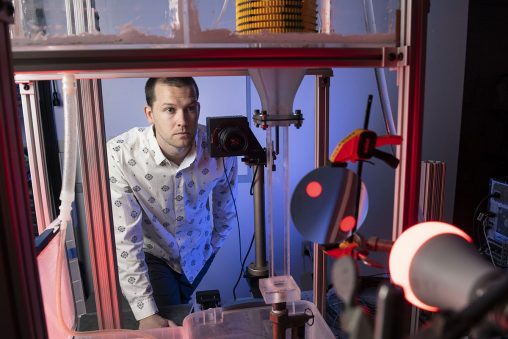
Mark Johnson, who earned a Ph.D. in Engineering from Wright State, uses dye visualization velocimetry to help calculate blood velocity and wall shear stress to help doctors more accurately predict how aneurysms rupture.
Mark Johnson, who graduated from Wright State University with a Ph.D. in Engineering in April, recently defended his doctoral dissertation, “Experimental and Numerical Studies on the Projective Dye Visualization Velocimetry in a Squared Vertical Tube.”
He also presented the paper at the 2023 Dayton-Cincinnati Aerospace Science Symposium, where he took first place in the Art in Science category.
Johnson said the goal of his research is to find a more accurate way to measure wall shear stress to more accurately predict how aneurysms rupture. He explained that wall shear stress is a tangential force, or a force that is parallel with the blood vessel wall, which causes damage. High shear stress is linked with inflammation to the aneurysm wall.
In order to measure this, medical professionals must first be able to accurately calculate the velocity of the blood through the blood vessel.
Johnson said medical professionals have tried calculating velocity through digital subtraction angiography imaging. Digital Subtraction Angiography imaging is a method for visualizing blood vessels that uses a contrast medium injected into the bloodstream and X-ray technology. Radiopaque structures such as bones are eliminated, or subtracted, digitally from the image, allowing for an accurate depiction of the blood vessels.
“They found that the velocity they calculated had quite a bit of error associated with it,” Johnson said. “We are trying to increase the accuracy of that. Dye visualization velocimetry is similar but allows us to use a light and dye set-up outside the body. The technique we developed uses machine learning to read the raw velocities acquired from dye visualization velocimetry and apply a correction to the values for improved accuracy.”
Johnson enrolled at Wright State as an undergraduate mechanical engineering student. He had received a scholarship for swimming and participated on Wright State’s swimming and diving team for four years, serving as co-captain in his junior and senior years. He also served on the Student-Athlete Advisory Committee for two years.
He was the recipient of the Raider Award in 2012 and was inducted into the Tau Beta Pi Engineering Honor Society.
Johnson earned his Bachelor of Science in Mechanical Engineering in 2015 and Master of Science in Mechanical Engineering in 2016 from Wright State.
After receiving his master’s degree, he worked at the Wright State University–Lake Campus for four years as a mechanical engineering lecturer, teaching courses in fluid dynamics and thermodynamics. After two years of teaching, he went back to pursue his Ph.D. in Engineering.
Johnson published nine journal papers during his master’s and Ph.D. studies at Wright State and received an ASME scholarship award during his Ph.D. program.
He works at GoHypersonic Inc. in Dayton.

 Wright State alum Lindsay Aitchison fulfills childhood space-agency dream
Wright State alum Lindsay Aitchison fulfills childhood space-agency dream  Wright State business professor, alumnus honored by regional technology organizations
Wright State business professor, alumnus honored by regional technology organizations  Wright State University Foundation awards 11 Students First Fund projects
Wright State University Foundation awards 11 Students First Fund projects  Gov. DeWine reappoints Board Treasurer Beth Ferris and names student Ella Vaught to Wright State Board of Trustees
Gov. DeWine reappoints Board Treasurer Beth Ferris and names student Ella Vaught to Wright State Board of Trustees  Joe Gruenberg’s 40-Year support for Wright State celebrated with Honorary Alumnus Award
Joe Gruenberg’s 40-Year support for Wright State celebrated with Honorary Alumnus Award 